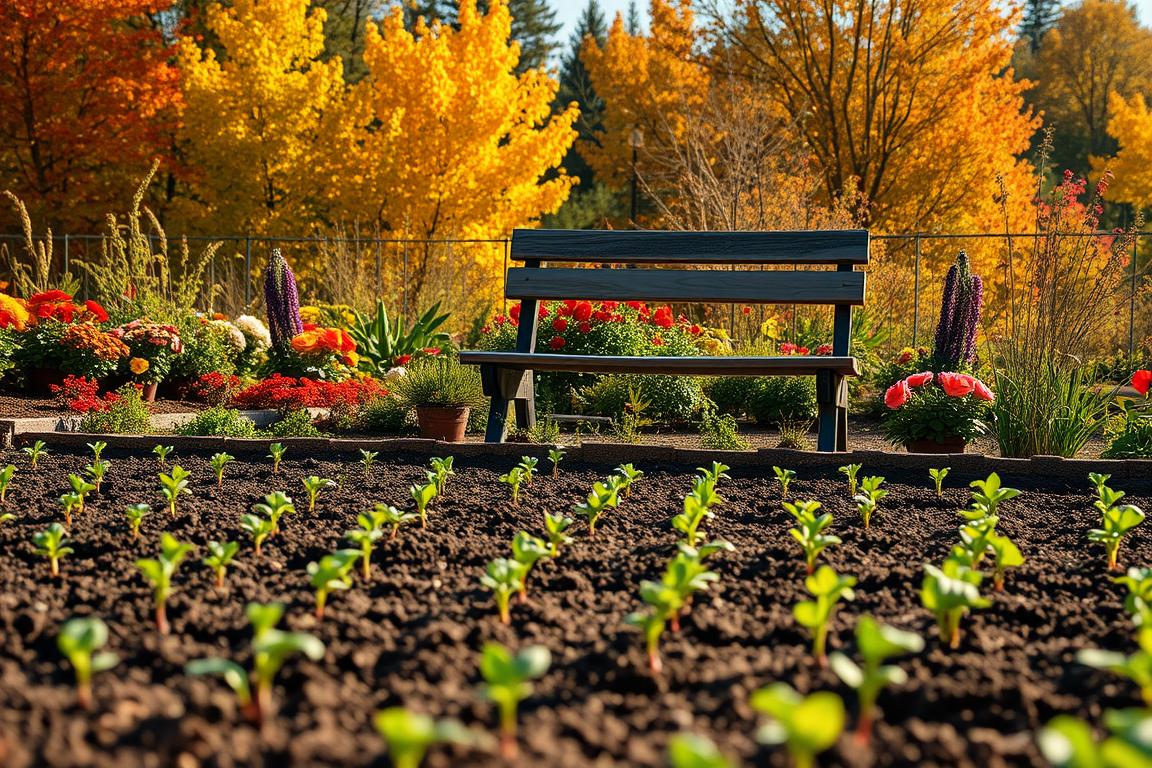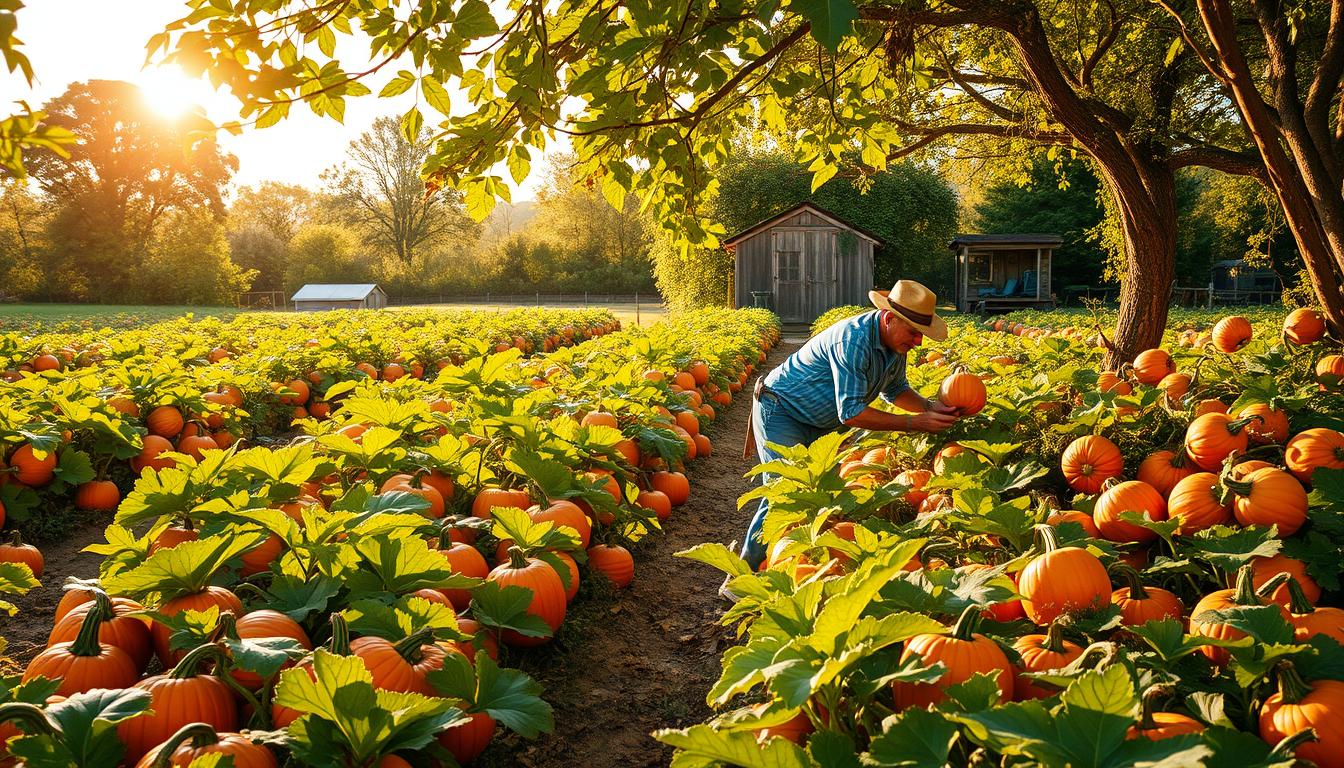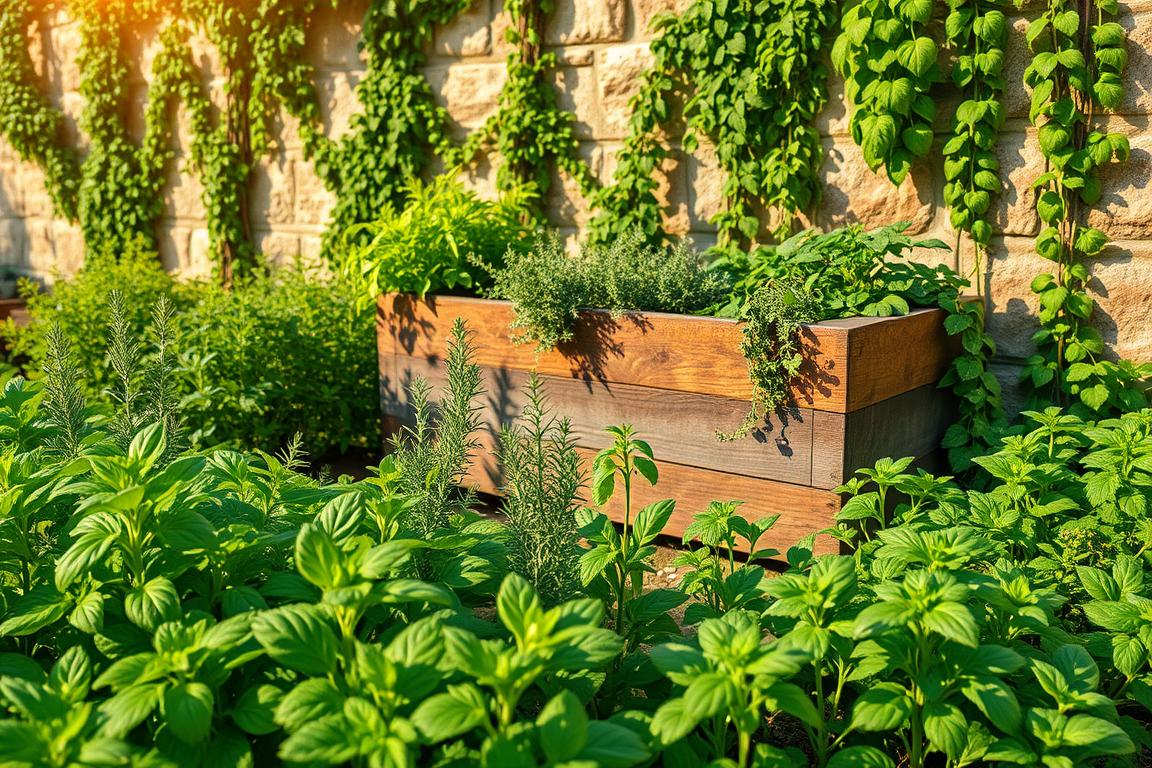The Christmas cactus (Schlumbergera x buckleyi) is a favorite tropical houseplant. It’s known for its vibrant winter flowers. Coming from Brazil’s rainforests, it loves humid places, unlike desert cacti.
With the right care, Christmas cacti can live for 100 years and bloom every year. They show off in colors like red, pink, white, and purple. These flowers usually last about two weeks.
These plants are easy to care for. They make great gifts during the holidays.
Key Takeaways
- The Christmas cactus is a tropical houseplant that blooms during the holiday season.
- These plants prefer humid environments and can live up to 100 years with proper care.
- Christmas cacti produce colorful flowers that last for about two weeks.
- They are relatively easy to grow, making them a popular choice for holiday gifts.
- Proper light, temperature, and moisture management are key to ensuring your Christmas cactus thrives.
Understanding the Christmas Cactus: Origins and Characteristics
The Christmas cactus, also known as the Schlumbergera, is a unique houseplant. It’s popular for its striking look and festive blooms. This plant is a hybrid, named after Frédéric Schlumberger. It has flat, segmented leaves and grows in a cascading way.
What is a Christmas Cactus?
The Christmas cactus is a holiday cactus from the Schlumbergera genus. This genus includes several species. These include the Thanksgiving cactus and the Easter cactus.
Different Types of Holiday Cacti
There are three main types of holiday cacti:
- Thanksgiving cactus (Schlumbergera truncata)
- Christmas cactus (Schlumbergera russelliana)
- Easter cactus (Rhipsalidopsis gaetneri)
Each holiday cactus has its own look and blooming time. They’re a favorite for houseplant maintenance and christmas cactus care tips.
Natural Habitat and Growth Patterns
The Schlumbergera genus comes from southeastern Brazil. It grows in humid, shady areas. These plants are epiphytic, growing on trees or in rock crevices.
Knowing the Christmas cactus’s origins and traits is key. It helps in giving the right schlumbergera care. This ensures the best blooming cycles for this unique houseplant.
How to Care for Christmas Cactus
Caring for a Christmas cactus is all about finding the right balance. You need to get the watering, lighting, and temperature just right. This way, your plant will bloom beautifully every year.
Watering Schedules
Water your Christmas cactus carefully. Let the soil dry a bit before you water again. In spring and summer, water every 7-10 days. Make sure the soil is moist but not too wet.
In fall and winter, water less often. Aim for every 4-6 weeks to prevent root rot.
Lighting Requirements
Christmas cacti love bright, indirect light. Place your plant where it gets 4-6 hours of diffused sunlight each day. Stay away from direct sunlight to avoid burning the leaves.
During fall and winter, give your plant 8-10 hours of complete darkness at night. This helps it bloom.
Soil and Repotting
Choose a soil mix that drains well and is slightly acidic. Repot your Christmas cactus every 3-4 years. Use terracotta or clay pots with holes for drainage.
When you repot, handle the roots gently. They are shallow and easily damaged.
Fertilizing and Pruning
Feed your Christmas cactus with a balanced, half-strength fertilizer once a month in spring and summer. Prune it after it blooms. This encourages more growth and a fuller plant.
By following these tips, your Christmas cactus will thrive. It will bring festive beauty to your home for many years.
| Care Aspect | Recommendations |
|---|---|
| Watering |
|
| Lighting |
|
| Soil and Repotting |
|
| Fertilizing and Pruning |
|
By following these care guidelines, you can help your Christmas cactus thrive and bring its festive blooms to your home for years to come.
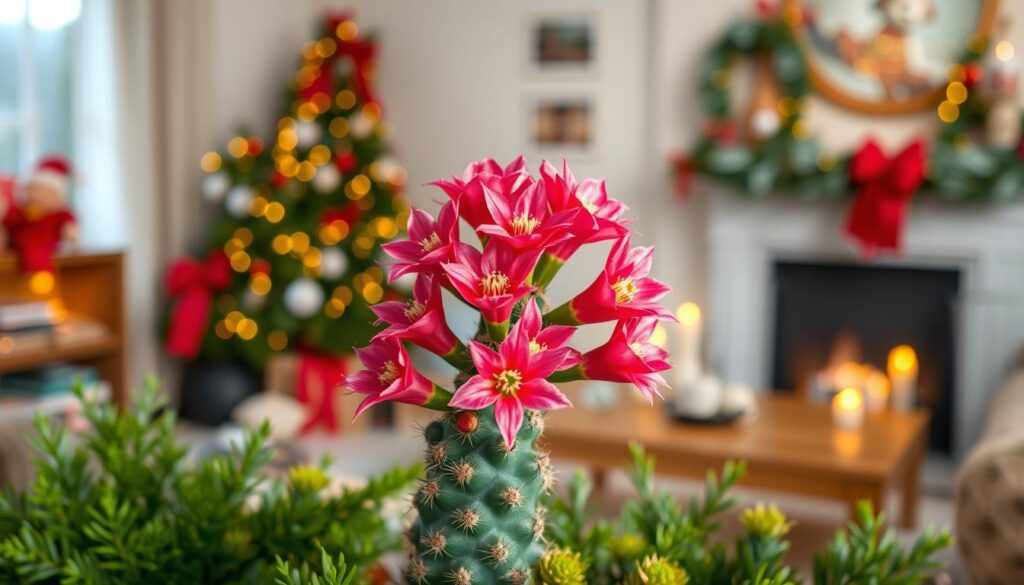
Creating the Perfect Environment for Blooming
To get your Christmas cactus to bloom beautifully, you need to create the right environment. These winter flowering houseplants need specific light and temperature conditions to thrive.
Light and Dark Cycle Requirements
Christmas cacti bloom best with a controlled light and dark cycle. They need 4-6 hours of indirect light during the day. Then, they need 13 hours or more of complete darkness at night. This cycle should last for at least 6 weeks to help buds form.
Temperature Control for Blooming
For the christmas cactus blooming process, keep the temperature cool. Aim for 60°F to 68°F during the bud development stage. Keeping this ideal temperature range for 6-8 weeks in the fall will encourage the growth of beautiful, seasonal blooms.
Moisture Management During Flowering
When your Christmas cactus is blooming, water it less to avoid root rot. Water every 4-6 weeks, letting the soil dry a bit between waterings. Also, avoid sudden temperature changes or drafts to prevent the flower buds from dropping too soon.
By giving your Christmas cactus the right holiday plant care, you’ll get a stunning display of seasonal blooms in the winter.
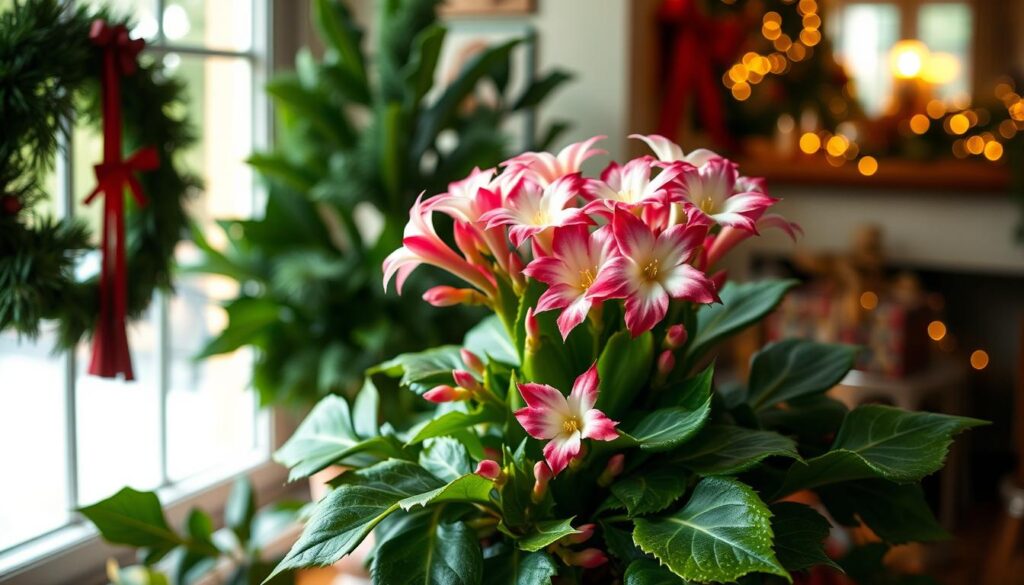
| Light and Dark Cycle | Temperature Range | Watering Frequency |
|---|---|---|
| 4-6 hours of bright, indirect light during the day; 13+ hours of complete darkness at night | 60°F to 68°F for 6-8 weeks | Every 4-6 weeks during flowering |
“Providing the right environmental conditions is key to enjoying the vibrant, seasonal blooms of the Christmas cactus during the holiday season.”
Propagation and Maintenance Tips
Caring for your Christmas cactus is more than just the right growing conditions. You also need to focus on christmas cactus propagation, cactus repotting, and cactus troubleshooting. These steps are crucial for your plant to thrive for years.
Propagating Christmas Cacti
To start, take cuttings from your Christmas cactus 1-2 months after it blooms. Choose healthy stems with 3-5 segments. Let the cuttings dry for a few days before planting them in moist, well-draining soil. You can also root them in water, which will take 2-3 weeks.
- Take cuttings 1-2 months after blooming
- Look for stems with 3-5 segments
- Allow cuttings to callus over before planting
- Propagate in soil or water for rooting
For seed propagation, collect ripe seed pods. Plant the seeds in a mix of sphagnum peat moss. Seedlings will emerge in a few weeks.
Maintaining Healthy Christmas Cacti
Christmas cactus are easy to care for, but there are a few important things to remember. They need the right holiday cactus growing conditions and protection from cactus pests and diseases:
- Repot every 3-4 years, as they prefer to be slightly root-bound.
- Watch for common pests like mealybugs, spider mites, and aphids, treating with insecticidal soap or horticultural oil.
- Avoid sudden temperature changes and maintain proper humidity to prevent bud drop.
- Monitor for signs of overwatering, which can lead to root rot and other fungal diseases.
By following these christmas cactus propagation and maintenance tips, your holiday cactus will thrive for many seasons.
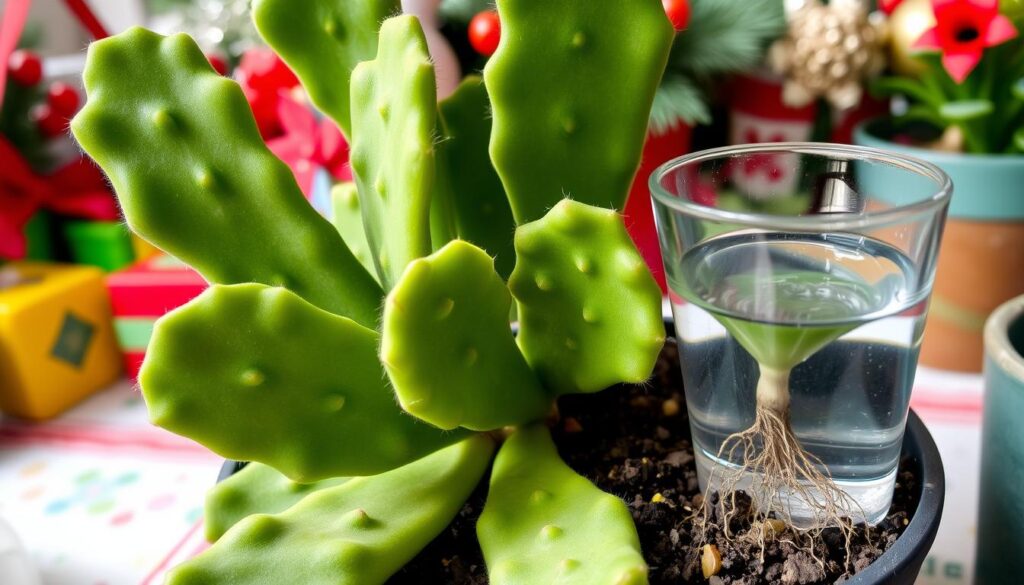
“With proper care, a Christmas cactus can live for decades, blooming beautifully year after year.”
Conclusion
Christmas cacti are stunning, easy-to-care-for plants that add color and cheer to your home in winter. They are a great choice for those looking for something different from traditional holiday plants. By following the right care tips, like watering, lighting, and temperature, you can enjoy their beauty for years.
These plants are perfect for any home, lasting up to 100 years. They are great for both experienced and new gardeners. This guide will help you grow and keep your Christmas cacti healthy and thriving. So, why not brighten up your home with a beautiful flowering cactus this holiday season?
With the right care, these plants will give you vibrant blooms that will impress everyone. They bring joy and beauty to your home during the winter. Let these plants become a special part of your holiday traditions.
FAQ
Q: What is a Christmas cactus?
A: The Christmas cactus is a tropical houseplant known for its colorful blooms in winter. It’s a hybrid named after Frédéric Schlumberger. It has flat, segmented leaves and grows in a cascading way.
Q: What are the different types of holiday cacti?
A: There are three main types of holiday cacti. These are the Thanksgiving cactus, Christmas cactus, and Easter cactus.
Q: How do Christmas cacti grow in their natural habitat?
A: Christmas cacti grow on trees or in rock crevices. They can grow up to 2 feet wide in a few years. They prefer partial shade or diffused light.
Q: How do I water a Christmas cactus?
A: Water Christmas cacti sparingly. Let the soil dry between waterings. Use a well-draining, slightly acidic soil mix.
Q: What lighting and temperature do Christmas cacti need?
A: Give them 4-6 hours of diffused light daily. Keep temperatures between 70-80°F during the growing season. Reduce watering and fertilizing in the fall to encourage blooming.
Q: How do I encourage Christmas cactus blooming?
A: To encourage blooming, give them 12-14 hours of darkness each night in the fall. Keep them cool (50-55°F) for 6-8 weeks to stimulate bud formation.
Q: How do I propagate a Christmas cactus?
A: Propagate 1-2 months after blooming. Take stem cuttings with 3-5 segments. Let them callous before planting in moist, well-draining soil.
Q: What common pests and diseases affect Christmas cacti?
A: Common pests include fungus gnats, thrips, aphids, spider mites, and mealybugs. Treat infestations with insecticidal soap or horticultural oil. Watch for signs of overwatering, which can lead to root rot.



